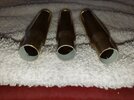You are using an out of date browser. It may not display this or other websites correctly.
You should upgrade or use an alternative browser.
You should upgrade or use an alternative browser.
Can We Talk About Sabots?
- Thread starter DMW1116
- Start date
GeoDudeFlorida
Member
- Joined
- Dec 1, 2020
- Messages
- 11,090
Hmmm… I’m not sure I’ve seen paper patching with smokeless. I don’t know if it won’t work but I also don’t know if it will - considering the pressure and heat of nitro powder I’m just not sure if it will hold up.I’ve wanted to try paper patched bullets since I started reloading cast bullets in my 30-30 a couple of years ago.
Maybe somebody has done it already?
Roverguy
Member
- Joined
- Jul 22, 2021
- Messages
- 888
Paper patches absolutely should separate from the bullet on exit from the barrel. If not, you’re doing it wrong. The paper patch should be sliced by the edges of the grooves as the bullet travels down the barrel and emerge as basically confetti at the muzzle. Any paper adhering to the bullet would negatively impact bullet stability and accuracy.No, the paper patch doesn’t separate from the bullet after it leaves the barrel, it’s attached and part of the bullet on impact. A sabot (Dutch word meaning “shoe”) falls off and remains behind as (or shortly after) the bullet leaves the muzzle. They operate in very different ways.
A properly applied paper patch is more nearly akin to a half jacket.
I’ve seen (video) and heard of it done with both black powder and smokeless. The first I heard of it was with 30-30 and bullets cast from softer lead and driven by smokeless powder. The paper patch removed the need for lube and gave some forgiveness on lead alloy selection. The bullet expanded to a greater degree than jacketed bullets. Velocity was in the range of usual cast bullet loads not 2200-2400 for standard 30-30 loads. The videos are done with 30-06 and 150 grain cast bullets. I’d have to watch again for more details.Hmmm… I’m not sure I’ve seen paper patching with smokeless. I don’t know if it won’t work but I also don’t know if it will - considering the pressure and heat of nitro powder I’m just not sure if it will hold up.
Maybe somebody has done it already?
That's what I'd heard, but I've not seen the results in person. I'm just going to have to buy the books and some sizing dies and try for myself. My ultimate goal is to be able to drive 7mm bullets from my 30-30 and 6.5mm bullets from something like a 270 Winchester or 6.8 SPC. These would be lever action, bolt action, or single shot. I have no desire to move such reduced, or not so reduced, loads to a gas or piston systems and fill the spaces with tissue paper.Paper patches absolutely should separate from the bullet on exit from the barrel. If not, you’re doing it wrong. The paper patch should be sliced by the edges of the grooves as the bullet travels down the barrel and emerge as basically confetti at the muzzle. Any paper adhering to the bullet would negatively impact bullet stability and accuracy.
Swampman
Old Fart
In my experience (mostly with smokeless powder and bottleneck rifle cartridges), the paper not only separates, but usually blows into confetti as it exits the bore.Interesting. I thought the paper separated eventually. Either right in front of the muzzle or 10-20 feet after.
Here's a link to a page dedicated to paper patching smokeless powder cartridges.
Roverguy
Member
- Joined
- Jul 22, 2021
- Messages
- 888
I am not well versed in the arcana of smokeless paper patching - deep juju indeed. But paper patching is really about creating a jacket for a lead bullet. I have huge doubts about it being used in the manner of a sabot. Usually, a sizing impact of greater than about .015” entails diminished accuracy but my experience is all in the .375 - .45 cal range. Good luck; it is through experimentation that we progress.That's what I'd heard, but I've not seen the results in person. I'm just going to have to buy the books and some sizing dies and try for myself. My ultimate goal is to be able to drive 7mm bullets from my 30-30 and 6.5mm bullets from something like a 270 Winchester or 6.8 SPC. These would be lever action, bolt action, or single shot. I have no desire to move such reduced, or not so reduced, loads to a gas or piston systems and fill the spaces with tissue paper.
I use the term sabot very loosely. What I really mean is any jacket/wrap/coating that allows a smaller sized bullet to be fired down a larger bore.I am not well versed in the arcana of smokeless paper patching - deep juju indeed. But paper patching is really about creating a jacket for a lead bullet. I have huge doubts about it being used in the manner of a sabot. Usually, a sizing impact of greater than about .015” entails diminished accuracy but my experience is all in the .375 - .45 cal range. Good luck; it is through experimentation that we progress.
GeoDudeFlorida
Member
- Joined
- Dec 1, 2020
- Messages
- 11,090
Great thread! I’ve learned a lot already and it’s still going! 
I’m curious about paper weights. I was taught to use 10lb cotton writing paper but it’s been established I was probably taught wrong. Is there a recommendation for smokeless vs smokeful or the same for everything?
I’m curious about paper weights. I was taught to use 10lb cotton writing paper but it’s been established I was probably taught wrong. Is there a recommendation for smokeless vs smokeful or the same for everything?
Jim Watson
Member
So I'll guess 2-3 MOA; a complete guesstimate.
Amazing, that is about what the Accelerators would do for me outside of short run flukes.
Wasn't there an AT round with ball bearing engraving rings so the shaped charge would not be spun up and its "jet" disrupted?
snowman357
Member
I remember somebody reloading them in 7.62x25, don't know about accuracy but I bet they were fast.
Jim Watson
Member
NRA did some work on paper patching nitro.
A thin wrap on a .284” standard 7mm bullet got a .288” .280 Ross back in action.
A thin wrap on a .284” standard 7mm bullet got a .288” .280 Ross back in action.
I was looking to use existing bullets so I had to find a size that was close enough to the next size that a couple paper wraps put it in the right diameter. That led down the path of trying to figure out various paper thicknesses. Just find some paper and start measuring. Save yourself some time and research. Paper weights and corresponding thicknesses is an arcane language I don’t have time to learn.Great thread! I’ve learned a lot already and it’s still going!
I’m curious about paper weights. I was taught to use 10lb cotton writing paper but it’s been established I was probably taught wrong. Is there a recommendation for smokeless vs smokeful or the same for everything?
Roverguy
Member
- Joined
- Jul 22, 2021
- Messages
- 888
Weight is a variable. It’s actually final diameter that matters. A high cotton content is great; makes for a more durable jacket. But, ideally, one wants a paper weight that, when double wrapped around the lead slug, delivers an overall diameter of about .001-.002” over groove diameter. Alloy may impact final diameter needs - soft lead obturates easily meaning the bullets acts much like a GG bullet, but without the leading risk. Thus, my doubts about using a paper patch to size out a @ .284 bullet to @ .310 and then propel it at smokeless velocities.Great thread! I’ve learned a lot already and it’s still going!
I’m curious about paper weights. I was taught to use 10lb cotton writing paper but it’s been established I was probably taught wrong. Is there a recommendation for smokeless vs smokeful or the same for everything?
Strongly recommend Paul Matthew’s “The Paper Jacket” as a great place to start this interesting journey.
That’s where I’m headed. The jump from 7mm to 30 cal seemed large, so I was headed toward a 0.300 sizing die to jump to 0.309-0.310. Alternatively, a 0.277 to 0.264 seems more reasonable. Also a 0.257 to 0.264 also seems doable.
I’ve looked into a couple of books, “The Paper Jacket” being one of them. I figure two books would be better than one, since this is new for me.
This all makes that 6.5 CM rifle more appealing. I can maybe shoot cast bullets for either 0.257 or 6.5 mm. A 140 grain 6.5 mm bullet at 270 Winchester 140 grain velocity sounds cool, but one must crawl before they walk. Then I remember my mom told me I walked first and only learned to crawl to get to something I could use to stand up.
I’ve looked into a couple of books, “The Paper Jacket” being one of them. I figure two books would be better than one, since this is new for me.
This all makes that 6.5 CM rifle more appealing. I can maybe shoot cast bullets for either 0.257 or 6.5 mm. A 140 grain 6.5 mm bullet at 270 Winchester 140 grain velocity sounds cool, but one must crawl before they walk. Then I remember my mom told me I walked first and only learned to crawl to get to something I could use to stand up.
JohnMc
Member
The French 105mm Obus HEAT round. "HEAT" means High Explosive Anti Tank - an explosive charge in the projectile pokes a hole in the armor. Apparently, it works a lot better if the round isn't spinning. Modern fin stabilized rounds fired from smooth bores fixed that, though I gather HEAT isn't so great against composite armor.Wasn't there an AT round with ball bearing engraving rings so the shaped charge would not be spun up and its "jet" disrupted?
FROGO207
Member
Back to the sabot 30-06 ammo. I had two packages of the gray ones that were made to use with .224 bullets. I tried everything from 50 grain to 63 grain bullets and the best accuracy I was able to get was with the 55 grain bullets and it was hard to get consecutive hits on a raccoon sized target at 40 YDS so I gave up.
An old timer that paper patched for black powder claimed no more than 2 turns and to use high rag content paper, like a US bill is made of. But I never tried it.
An old timer that paper patched for black powder claimed no more than 2 turns and to use high rag content paper, like a US bill is made of. But I never tried it.
Nature Boy
Member
- Joined
- Apr 21, 2015
- Messages
- 8,256
Hmm, what is the MOA accuracy of an anti-tank saboted shot? Seems like we could do better in small arms.
Sabot rounds fired from any modern main battle tank are VERY accurate.
I messed around with them in 7.62x25 , 30 carbine and 30-06. None were great in the accuracy department, the 7.62x25 didn't cycle the pistol either. But I have a bunch of the sabots yet, even bought some for 45 cal I'm going to play around with 40 cal bullets in my 45 Colt Blackhawk and Old Army.I remember somebody reloading them in 7.62x25, don't know about accuracy but I bet they were fast.
Similar threads
- Replies
- 2
- Views
- 504
- Locked
- Replies
- 3
- Views
- 958
- Locked
- Replies
- 5
- Views
- 835



